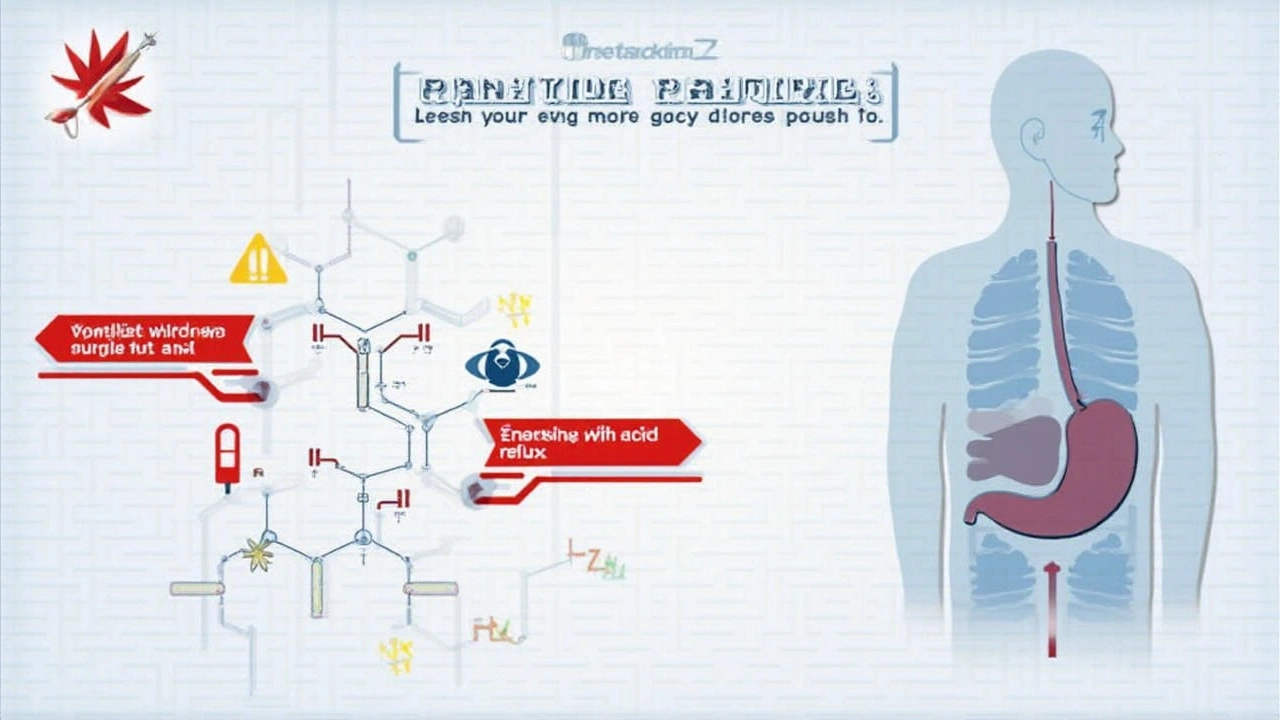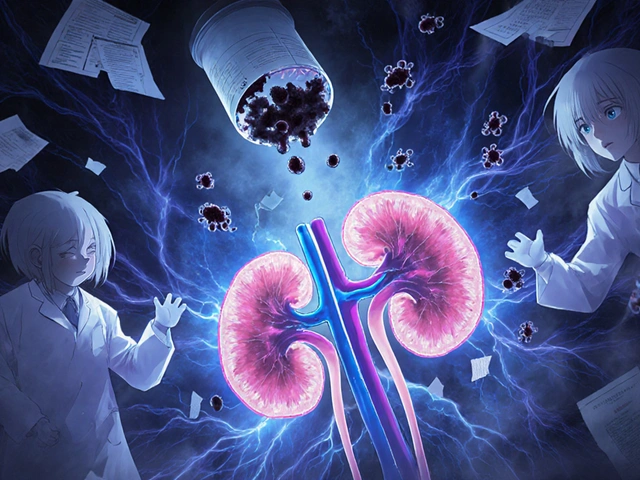
Got heartburn? For decades, a little pink pill called Zantac was one of the most common fixes. Doctors recommended it in droves. You could spot it on pharmacy shelves everywhere, right next to Prilosec and Tums. It was like aspirin for acid reflux—until everything changed almost overnight. Suddenly, headlines popped up everywhere warning about cancer risks. Pharmacies started sweeping it off their shelves. Talk about whiplash. What happened with Zantac and why did it go from a household staple to a major recall? If you’ve ever used it—or if you just want to know how to ease heartburn safely—these facts absolutely matter.
Back in the 1980s, Zantac, or ranitidine as it’s known generically, was the new hero in town for acid reflux. Until then, options were pretty limited. Antacids like Tums or Maalox offered quick relief from sour stomach, but they didn’t last long. Enter Zantac, approved by the FDA in 1983, and suddenly millions could keep heartburn in check for hours. It worked by blocking histamine receptors in the stomach lining, which meant less acid got pumped out. Unlike the fast, fleeting comfort from antacids, Zantac let users get ahead of the burning sensation in the first place.
This wasn’t just a small win; it was huge for people living with constant discomfort. In its first ten years on the market, Zantac became one of the world’s best-selling drugs. Hospitals, family clinics, and medicine cabinets were all stocked with it. People took it in pill form, syrup, and even IV in hospitals for more serious conditions. The brand name itself became sort of a shorthand for heartburn, just like Kleenex is for tissues. In fact, for most of the 1990s and early 2000s, Zantac held a top spot on lists of prescribed medications worldwide, exceeding $1 billion in global sales almost every year at its peak.
Zantac wasn’t just about heartburn. It was prescribed for ulcers, gastritis, GERD, and even as prevention for those who had to take pain meds that could irritate their stomach.
But like so many blockbuster drugs before it, the excitement didn’t last forever. By the mid-2010s, newer medications called proton pump inhibitors (think omeprazole and lansoprazole) started snatching up Zantac’s turf, mostly thanks to stronger, longer-lasting effects. Still, ranitidine kept its place as a tried-and-true favorite. That is, until a surprising discovery pulled the rug out from underneath.
The plot twist hit in September 2019. Independent labs like Valisure tested batches of ranitidine drugs—including Zantac—only to find high levels of NDMA (N-Nitrosodimethylamine). That’s not just a complicated name; NDMA is a probable human carcinogen. In other words, scientists believe it can cause cancer if consumed in large enough quantities over time. How did NDMA end up in a medicine trusted by millions?
Turns out, ranitidine has a quirky chemical structure. When exposed to heat—like sitting in a hot warehouse or mail truck—or even during normal digestion, it can break down and create NDMA inside the body and in the packaging itself. The FDA confirmed those test results, and suddenly, it wasn’t just one manufacturer at risk. By April 2020, the FDA called for a full recall of all ranitidine products, including all generic versions and the original Zantac brand. Pharmacies were told to take every last box off their shelves. Patients were told to stop taking it and call their doctors about safer options.
If you’re looking for the hard numbers: a study out of Stanford in late 2019 found that heat-exposed ranitidine samples produced NDMA—sometimes hundreds of times above the FDA’s daily safe limit (currently 96 nanograms). That’s not a little slip; it’s a real red flag.
So, why did it take so long to catch this? For years, earlier tests either didn’t pick up the problem or assumed it was rare. Only with new, more sensitive methods did the NDMA issue become crystal clear. The discovery led to a domino effect: lawsuits, more recalls, and a huge push for drugmakers to check for similar contaminants in other common meds.
Some doubters wondered if all this was overblown. Government health agencies worldwide reviewed the evidence. Ultimately, precation tipped the scales: only a full recall could assure people that their meds were safe. Healthcare providers everywhere had to pivot quickly, switching patients to alternatives and updating treatment protocols on the fly. The recall covered not just pills, but syrups, effervescent tablets, and injectable forms as well.
| Year | Total US Zantac Sales (USD) | Number of Prescriptions | FDA Safety Alerts |
|---|---|---|---|
| 2015 | $212 million | 13 million | 0 |
| 2018 | $129 million | 8.8 million | 0 |
| 2020 | N/A (off market) | N/A | 1 (Recall) |
Even today, some people still have old Zantac bottles gathering dust at home. If that’s you, you really shouldn’t use them—NDMA forms over time, so the risk goes up the older the pills get. The FDA recommends tossing old Zantac products in a drug take-back bin or following disposal guidelines on their website. Just flushing them isn’t ideal, since NDMA can impact water quality, too.

The million-dollar question: does Zantac really cause cancer? Scientists are a cautious bunch. It’s not always easy to go from lab findings to real-world impact. What we know: NDMA is linked to an increased risk of several cancers, including stomach, bladder, and colorectal cancers, in animal studies and some human observations. In 2020, researchers at Memorial Sloan Kettering reported that people exposed to high NDMA levels from contaminated water and processed meats were more likely to develop certain cancers. Crowdsource that across millions of Zantac users, and, well, you see why regulators acted fast.
By early 2021, about 100,000 lawsuits had piled up against the makers of Zantac, including big names like Sanofi and GlaxoSmithKline. People who had taken Zantac for years—sometimes decades—claimed their cancers were linked to the drug. Law firms ran TV ads looking for clients. A few major cases even went to trial. Most haven’t been settled yet as independent scientific panels continue to review medical records and lab data. At the same time, the companies maintain that the cancer risks have never been definitively proven in people taking normal doses. It’s complicated, and emotions run high.
It’s not just about lawsuits, though. Several big studies have looked for a direct tie between ranitidine and cancer. For instance, a 2021 analysis published in the Journal of the American Medical Association couldn’t find a clear surge in cancer rates among Zantac users—at least, not yet. But the problem is, many cancers take years to develop. The total risk might only become obvious in the next decade or so. Plus, so far, studies can’t always control for things like alcohol use, smoking, or diet, all of which influence stomach cancer risk—so it’s a murky puzzle.
Medical advice now is don’t panic, but don’t mess around, either. If you relied on Zantac for years, get regular checkups and talk to your doctor if any new symptoms crop up—especially unexplained stomach pain, blood in your stool or urine, or persistent nausea. Doctors are on alert for these links, so you won’t be navigating it on your own.
Here’s a quick tip: always keep a list of medications you’ve taken—especially prescriptions you used long-term. It makes it a whole lot easier to track potential risks and have informed chats with your healthcare provider. And if you ever wonder if a new health symptom could be related to Zantac, mention your history, including how long and how often you took it.
If Zantac was your old stand-by, you’re probably wondering what’s safe now. Thankfully, acid reflux has plenty of other treatments, and not all medicines in this family have the same NDMA problem. H2 blockers, the class of drugs Zantac belonged to, have other members: famotidine (Pepcid) and cimetidine (Tagamet). The FDA ran extra tests on them, and, as of now, both have come back clean. Pepcid, in particular, is a favorite replacement—same class, similar relief, but no NDMA. The key word here is: alternatives to zantac.
Proton pump inhibitors (PPIs) like omeprazole or lansoprazole are even stronger. They work by crushing stomach acid production at the source and are often recommended if heartburn is relentless or connected to erosive esophagitis (that’s when acid starts damaging your throat lining). These are available over-the-counter or by prescription, depending on the dose.
Of course, pills aren’t the only answer—sometimes, a few lifestyle changes make a bigger difference than any drug. Here are some real-world tips that work for most people struggling with heartburn or mild acid reflux:
If you absolutely need medication for reflux, talk to your doctor or pharmacist before grabbing the nearest bottle. They’ll help you pick what’s safest based on your medical history, especially if you’re taking other pills or have long-term health conditions.
It’s worth mentioning that Zantac technically came back under a new name—Zantac 360, which contains famotidine, not ranitidine. So, if you see that in stores, just know you’re getting a totally different molecule. Always double-check the box for active ingredients so you don’t accidentally grab an old stock or mistake the formula.
One more tip: check your medicine cabinet every few months. Meds don’t last forever, and labels can change. This is a good time to toss anything recalled, expired, or that you can’t even remember why you have. Ask your pharmacist anytime you see a drug recall on the news—they can explain the details and recommend safer swaps.
Your stomach deserves safe relief, and nobody should have to gamble with their health just to squash some heartburn. Stay curious, double-check those labels, and don’t be shy about asking questions. That’s how you make smart, healthy choices—without the drama or risk that came with Zantac’s downfall.
Heartburn warriors, brace yourselves!!! The Zantac saga reads like a blockbuster thriller, complete with hidden villains, surprise twists, and a climactic recall that left millions gasping for relief!!! 🚀
The piece correctly identifies NDMA as a probable carcinogen, yet it mistakenly pluralises “risk” in the final paragraph.
Honestly, I think people are overreacting 😜 the NDMA levels in ranitidine are hardly a death sentence, especially when you consider the dose‑response curve is far from linear and most users never hit the toxic threshold.
While the recall was swift, it’s worth noting that alternatives like famotidine have a solid safety record and are readily available over‑the‑counter for most consumers.
From a pharmacovigilance standpoint, the Zantac recall underscores the critical importance of post‑marketing surveillance and analytical method validation, particularly for nitrosamine impurities that can emerge under stress conditions such as thermal degradation.
In the case of ranitidine, the molecule’s secondary amine functional group is prone to nitrosation, a pathway that is catalysed by nitrous acid generated in situ during storage or gastrointestinal transit.
This mechanistic insight has propelled regulatory agencies worldwide to issue guidance on acceptable daily intake limits for N‑nitrosodimethylamine, establishing a threshold of 96 ng per day as the benchmark for safety.
Clinically, the latency period for nitrosamine‑induced oncogenesis is protracted, often spanning decades, which complicates epidemiological attribution of cancer incidence to a single pharmaceutical exposure.
Nevertheless, the actuarial risk calculations employed by the FDA incorporate probabilistic models that weigh cumulative exposure against background cancer rates, thereby justifying precautionary recalls when upper confidence limits exceed acceptable risk tolerances.
From an industry perspective, the detection of NDMA in Zantac catalysed a cascade of corrective actions, including reformulation, enhanced manufacturing controls, and the adoption of more robust analytical techniques such as liquid chromatography–tandem mass spectrometry (LC‑MS/MS).
Moreover, the incident has spurred cross‑sector collaborations, with consortia of generic manufacturers sharing best practices to mitigate nitrosamine formation across the drug supply chain.
On the patient side, healthcare providers are encouraged to conduct medication reconciliation, explicitly querying patients about any historical ranitidine usage and documenting potential exposure in the electronic health record.
Pharmacists play a pivotal role in counseling, emphasizing the importance of disposing of obsolete Zantac stock through authorised drug take‑back programmes to prevent environmental contamination.
Environmental toxicology literature has highlighted that NDMA, being highly water‑soluble, can infiltrate aquatic ecosystems if disposed of improperly, raising concerns about bioaccumulation in fish and subsequent human exposure via the food chain.
In terms of therapeutic alternatives, H2‑receptor antagonists such as famotidine and cimetidine have demonstrated negligible nitrosamine formation under comparable stress tests, rendering them viable substitutes for acid‑related disorders.
Proton pump inhibitors, while more potent, also undergo rigorous impurity profiling to ensure they meet the same safety standards as their H2‑blocker counterparts.
From a health economics angle, the shift away from Zantac has generated market opportunities for generic manufacturers of famotidine, with projected sales growth aligning with the increasing prevalence of gastro‑oesophageal reflux disease in aging populations.
Ultimately, the Zantac episode serves as a case study in the dynamic interplay between drug safety science, regulatory oversight, and clinical decision‑making, reminding all stakeholders that vigilance is paramount in safeguarding public health.
Switch to famotidine now-don’t gamble with your gut.
old zantac can be risky keep it out of the house
Yo folks, ditch the pink pills and grab a Pepcid, your stomach will thank you!
It’s a moral imperative to question why corporations were allowed to push a carcinogenic product onto unsuspecting consumers for decades.
Not so fast, the so‑called “overreaction” ignores the fact that America’s health standards must be uncompromising.
The narrative presented suffers from a lack of epistemic rigor, relying heavily on sensationalist language rather than a methodical exposition of the pharmacological data.
Data trends reveal a statistically significant uptick in NDMA contamination incidents across multiple batches, which, when plotted, illustrate a clear correlation between storage temperature fluctuations and impurity levels 😊.
In the grand tapestry of medicine, the Zantac episode reminds us that ethical stewardship must accompany scientific progress.
When a nation’s pharmaceutical guardians betray their duty, it roils the collective soul, painting a vivid scar across the canvas of public trust.
According to FDA guidelines the acceptable daily intake for NDMA is 96 ng; any exposure exceeding this threshold warrants immediate corrective action.
Great rundown everyone-if you’re still unsure which option suits you best, reach out to a pharmacist for a personalized recommendation.
